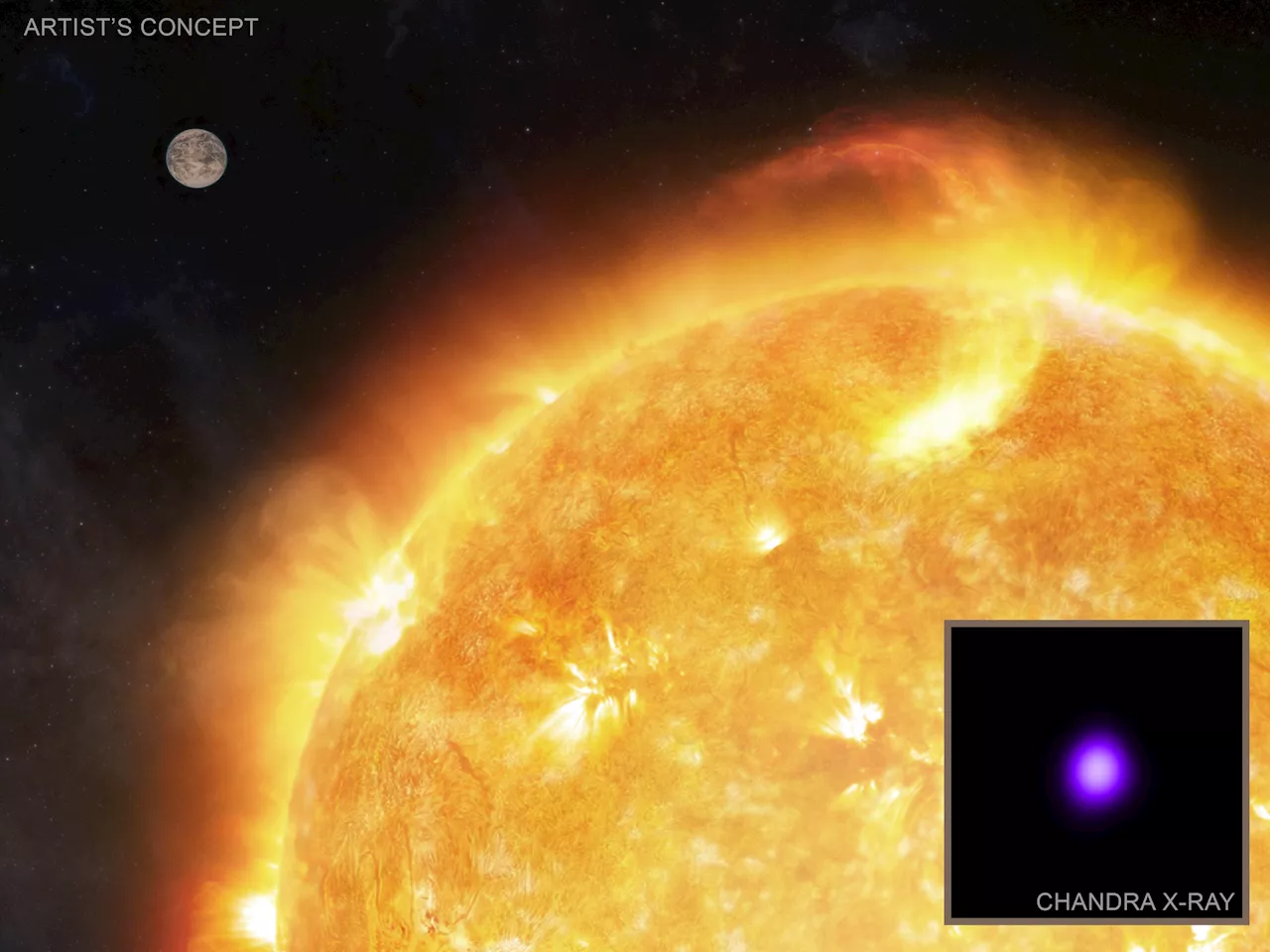A new study using NASA's Chandra X-ray Observatory and ESA's XMM-Newton reveals that the close-by red dwarf star Wolf 359 emits intense X-rays and ultraviolet radiation, posing a significant threat to the habitability of planets orbiting it. The research highlights the importance of greenhouse gases and distance from the star for sustaining life.
This artist’s illustration represents the results from a new study that examines the effects of X-ray and other high-energy radiation unleashed on potential exoplanets from Wolf 359 , a nearby red dwarf star . Researchers used Chandra and XMM-Newton to study the impact of steady X-ray and energetic ultraviolet radiation from Wolf 359 on the atmospheres of planets that might be orbiting the star.
They found that only a planet with greenhouse gases like carbon dioxide in its atmosphere and at a relatively large distance away from Wolf 359 would have a chance to support life as we know it. Planets around other stars need to be prepared for extreme weather conditions, according to a new study from NASA’s Chandra X-ray Observatory and ESA’s (European Space Agency’s) XMM-Newton that examined the effects of X-rays on potential planets around the most common type of stars. Astronomers found that only a planet with greenhouse gases in its atmosphere like Earth and at a relatively large distance away from the star they studied would have a chance to support life as we know it around a nearby star. Wolf 359 is a red dwarf with a mass about a tenth that of the Sun. Red dwarf stars are the most common stars in the universe and live for billions of years, providing ample time for life to develop. At a distance of only 7.8 light-years away, Wolf 359 is also one of the closest stars to the solar system. “Wolf 359 can help us unlock the secrets around stars and habitability,” said Scott Wolk of the Center for Astrophysics | Harvard & Smithsonian (CfA), who led the study. “It’s so close and it belongs to such an important class of stars – it’s a great combination.” Because red dwarfs are the most prevalent types of stars, astronomers have looked hard to find exoplanets around them. Astronomers have found some evidence for two planets in orbit around Wolf 359 using optical telescopes, but those conclusions have been challenged by other scientists. “While we don’t have proof of planets around Wolf 359 yet, it seems very possible that it hosts multiple planets,” Wolk added. “This makes it an excellent test bed to look at what planets would experience around this kind of star.” Wolk and his colleagues used Chandra and XMM to study the amounts of steady X-rays and extreme ultraviolet (UV) radiation – the most energetic type of UV radiation – that Wolf 359 would unleash on the possible planets around it. They found that Wolf 359 is producing enough damaging radiation that only a planet with greenhouse gases like carbon dioxide in its atmosphere – and located at a relatively large distance from the star – would likely be able to sustain life. “Just being far enough away from the star’s harmful radiation wouldn’t be enough to make it habitable,” said co-author Vinay Kashyap, also of CfA. “A planet around Wolf 359 would also need to be blanketed in greenhouse gases like Earth is.” To study the effects of energetic radiation on the habitability of the planet candidates, the team considered the star’s habitable zone – the region around a star where liquid water could exist on a planet’s surface. The outer limit of the habitable zone for Wolf 359 is about 15% of the distance between Earth and the Sun, because the red dwarf is much less bright than the Sun. Neither of the planet candidates for this system is located in Wolf 359’s habitable zone, with one too close to the star and the other too far out. “If the inner planet is there, the X-ray and extreme UV radiation it is subjected to would destroy the atmosphere of this planet in only about a million years,” said co-author Ignazio Pillitteri of CfA and the National Institute for Astrophysics in Palermo, Italy. The team also considered the effects of radiation on as-yet undetected planets within the habitable zone. They concluded that a planet like the Earth in the middle of the habitable zone should be able to sustain an atmosphere for almost two billion years, while one near the outer edge could last indefinitely, helped by the warming effects of greenhouse gases. Another big danger for planets orbiting stars like Wolf 359 is from X-ray flares, or occasional bright bursts of X-rays, on top of the steady, everyday output from the star. Combining observations made with Chandra and XMM-Newton resulted in the discovery of 18 X-ray flares from Wolf 359 over 3.5 days. Extrapolating from these observed flares, the team expects that much more powerful and damaging flares would occur over longer periods of time. The combined effects of the steady X-ray and UV radiation and the flares mean that any planet located in the habitable zone is unlikely to have a significant atmosphere long enough for multicellular life, as we know it on Earth, to form and survive. The exception is the habitable zone’s outer edge if the planet has a significant greenhouse effec
Wolf 359 Red Dwarf Star Exoplanets X-Ray Radiation Ultraviolet Radiation Habitable Zone Greenhouse Gases
United States Latest News, United States Headlines
Similar News:You can also read news stories similar to this one that we have collected from other news sources.
 Wolf Man: Universal Are Still Dummies, Featurette Spotlights The WolfEverything changes under the light of the Wolf Moon. WolfManMovie only in theaters FRIDAY. Get tickets now: Link/Link in bio. ----- From Blumhouse and visionary writer-director Leigh Whannell, the creators of the chilling modern monster tale The Invisible Man, comes a terrifying new lupine nightmare: Wolf Man.
Wolf Man: Universal Are Still Dummies, Featurette Spotlights The WolfEverything changes under the light of the Wolf Moon. WolfManMovie only in theaters FRIDAY. Get tickets now: Link/Link in bio. ----- From Blumhouse and visionary writer-director Leigh Whannell, the creators of the chilling modern monster tale The Invisible Man, comes a terrifying new lupine nightmare: Wolf Man.
Read more »
 Lori Loughlin Embraces New Challenge as 'Strong Character' in Dick Wolf's 'On Call'Lori Loughlin, known for her wholesome roles, steps into a new world with Lieutenant Bishop in Dick Wolf's 'On Call'. The Prime Video procedural sees Loughlin playing a powerful woman in a male-dominated field, a departure from her previous typecasting. Loughlin credits costar and director Eriq LaSalle for his support and guidance in navigating this challenging role.
Lori Loughlin Embraces New Challenge as 'Strong Character' in Dick Wolf's 'On Call'Lori Loughlin, known for her wholesome roles, steps into a new world with Lieutenant Bishop in Dick Wolf's 'On Call'. The Prime Video procedural sees Loughlin playing a powerful woman in a male-dominated field, a departure from her previous typecasting. Loughlin credits costar and director Eriq LaSalle for his support and guidance in navigating this challenging role.
Read more »
 Box Office Battle: Wolf Man, One of Them Days Challenge Den of Thieves 2Three films clash for box office dominance this weekend as 'Wolf Man,' 'One of Them Days,' and 'Den of Thieves 2: Pantera' compete for audience attention.
Box Office Battle: Wolf Man, One of Them Days Challenge Den of Thieves 2Three films clash for box office dominance this weekend as 'Wolf Man,' 'One of Them Days,' and 'Den of Thieves 2: Pantera' compete for audience attention.
Read more »
 Chornobyl Dog Study Finds No Evidence of Radiation-Induced Genetic MutationsResearchers examine the genomes of dogs living near the Chornobyl disaster site to determine if radiation exposure caused genetic differences. Results indicate no radiation-induced mutations but suggest selective pressures may have played a role.
Chornobyl Dog Study Finds No Evidence of Radiation-Induced Genetic MutationsResearchers examine the genomes of dogs living near the Chornobyl disaster site to determine if radiation exposure caused genetic differences. Results indicate no radiation-induced mutations but suggest selective pressures may have played a role.
Read more »
 Mayfield Looks to Follow Up 27-32, 359 Yds, 5 TDs Game as Buccaneers Play Host to Saints in Raymond James StadiumThe Tampa Bay Buccaneers host the New Orleans Saints in Week 18 of the NFL season. The game features quarterback Baker Mayfield looking to repeat his impressive performance from the previous week. Notable inactives include Buccaneers safety Jordan Whitehead due to a car accident and Saints wide receiver Chris Olave due to a concussion.
Mayfield Looks to Follow Up 27-32, 359 Yds, 5 TDs Game as Buccaneers Play Host to Saints in Raymond James StadiumThe Tampa Bay Buccaneers host the New Orleans Saints in Week 18 of the NFL season. The game features quarterback Baker Mayfield looking to repeat his impressive performance from the previous week. Notable inactives include Buccaneers safety Jordan Whitehead due to a car accident and Saints wide receiver Chris Olave due to a concussion.
Read more »
 Hawley Blasts Johnson After Radiation Bill Excluded From Funding PlanSenator Josh Hawley criticized Senate Majority Leader Mitch McConnell after his bill to compensate victims of nuclear weapons testing was left out of the final funding bill. The compromise, led by Sen. Mike Lee (R-UT), would have been a six-year reauthorization of the radiation exposure program with a $10 billion price tag. However, many Republicans believe the program should be winding down, not ramping up. Hawley's allies counter that the law, which expired in June, excludes geographic areas where residents have been poisoned by uranium mining and the improper storage of radioactive waste.
Hawley Blasts Johnson After Radiation Bill Excluded From Funding PlanSenator Josh Hawley criticized Senate Majority Leader Mitch McConnell after his bill to compensate victims of nuclear weapons testing was left out of the final funding bill. The compromise, led by Sen. Mike Lee (R-UT), would have been a six-year reauthorization of the radiation exposure program with a $10 billion price tag. However, many Republicans believe the program should be winding down, not ramping up. Hawley's allies counter that the law, which expired in June, excludes geographic areas where residents have been poisoned by uranium mining and the improper storage of radioactive waste.
Read more »
